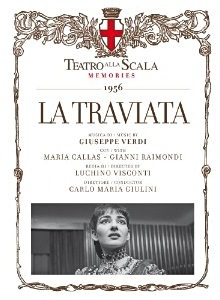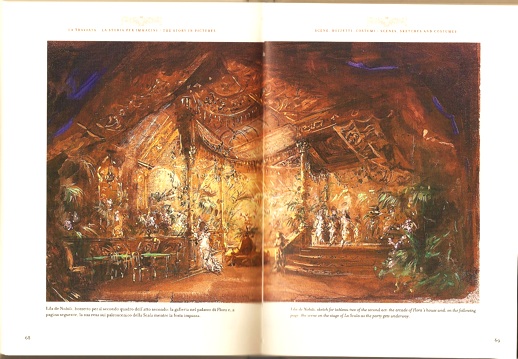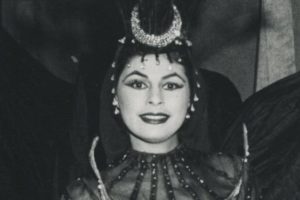
We approach, beloveds, as unto a shrine, for these are no ordinary performances. Nay, for most opera lovers this is the equivalent of a trip to Lourdes, Oberammergau and the Holy See in Rome with 24-bit digital remastering laid on. For Our Lady Maria Meneghini Callas sacrificed her voice on the stage of La Scala so that we may all live on with the memories for ever and ever. Amen.
The lovely people who run that big theatre in Milan have decided it’s high time to publish their trove of treasures since all the other opera houses are already in on the game. Vienna and the Salzburg Festival, Glyndebourne, Covent Garden, and the Met have all been releasing archival performances now for years and some of them quite wonderful indeed. Not to be outdone, La Scala is publishing small format (7.5” by 5.5”, exact measurements are always important) hardback books called Memories with dozens of delicious archival performance and backstage photos and set and costume designs.
Many of these even I have not seen before. Beautifully printed on heavy cream paper just the two I’ve been given to review seem well worth the slightly increased cost just for presentation alone.
“Callas alla Scala” is labeled Volume I: Bel Canto and includes mostly arias and three duets from Norma, Barbiere, Lucia, Sonnambula, Anna Bolena, Il Turco in Italia and Puritani. Odd, that in the case of the Turco and Puritani excerpts they use the EMI studio recordings but they bring a welcome relief to the ears after sampling what the engineers at Italian Public Broadcasting (RAI) hath wrought in the 1950’s.
I became an opera fan at the birth of digital recording so it was sound quality that was my foremost consideration when judging a performance for a while. It has become more apparent, as I’ve grown older… er, wiser, that studio recordings are really just hothouse tomatoes, beautiful on the outside but only a facsimile of the genuine fruit. For those of us who were hoping (praying) that La Scala had some secret inventory of pristine sound sources they’d been holding back to publish let me just tell you to just abandon that glimmer now. All of these sound no better, but no worse, than the last round of EMI re-masterings in 1997. I guess this is as good as it’s ever going to get. Let’s bow our heads, brothers and sisters, and begin.
We start off with the “Casta Diva” and “Mira, o Norma” duet from the 1955 relay with Antonio Votto conducting. For my money this is her best performance of Norma. She’s rock solid throughout with that magnificent, molten steel, legato. The 46 pages of photos include some mirth-inducing, carefully posed, trés trés casual rehearsal shots with Giulietta Simionato and Mario Del Monaco, plus performance pics that reveal some of the worst costumes La Divina surely ever had to endure. Norma with cloak of ermine tails?
The Barbiere duet with Gobbi is next and she gives everyone listening a singing lesson.
Then, suddenly, the technical clouds break and we’re in Berlin 1955 with Karajan conducting Lucia. It goes without saying that is one of the greatest live recordings ever made, and I want to kiss all those German audio rocket scientists for giving us one of the great examples of Callas at her peak. Sadly, then back to the bottom of the RAI well for the rest of the disc with the final scenas of both Bolena and Sonnambula. Still, it’s a lovely compilation in a deluxe packaging that makes a wonderful gift for yourself, or sure, someone else.
Next, the Traviata. Not the (1955) Traviata but the following year’s revival from 1956 with Carlo Maria Giulini back in the pit and Ettore Bastianini as Papa Germont, but featuring Gianni Raimondi stepping in for the absent Giuseppe DiStefano as Alfredo. (I believe DiStefano had displeased Madame with his boorish behavior during the initial rehearsals and run of the year previous so he was not invited back. ) It was Raimondi’s La Scala debut and he makes an ideal Alfredo. A singer I have long admired who was needlessly overshadowed throughout his career during a time when great tenors were dropping out of the trees. It’s a lovely, full lyric voice with excellent and colorful diction. He just never had the movie star quality in timbre or demeanor of others.
This performance has been available before on pirate labels but not part of the EMI canon. Sound has been warmed up but we’re still listening with the RAI cotton in our ears. It’s not horrible… all the time. Bastianini sounds more bass than baritone and although it’s a profoundly beautiful voice, that he does manage to lighten in parts, I miss the cantabile quality on the top of the range that you get with a true high baritone in this role.
Callas is protean and gives even more in spots than she did the year before. It’s surprising to hear, being so used to listening to her in the studio, how willing she is to take advantage of the moment. She’s always deeply musical even when she turns her ”Amami, Alfredo” into an apocalypse, catch breaths and all. Not to say that her interpretation hasn’t been carefully mapped with the help, no doubt, of Giulini who sticks to her like glue. A magnificent Act I scena capped by a stunningly confident cabaletta. Giulini pulls Violetta’s long arching phrases during the gambling scene out far longer than you think he should and makes it work. Her last act is a devastation. The audience reactions throughout make most sporting events seem like a Librarian’s convention.
Both books have essays on Callas and the particular productions. The Traviata includes a dissertation on the opera and a performance history at La Scala that shows how shockingly few times it’s been produced since: only three more stagings stagings from 1956. Over 40 pages of black and white photos shot on the stage, backstage and during the calls are joined by a very few color representations of Lila de Nobili’s costumes and sets. All text and captions are furnished in Italian and English and the translations of the essays, in particular, come off a tad stilted: either comically unfamiliar with the English language or just much way too academic.
For any serious Callas fanatic, and you know who you are, you’re probably already clutching this one to your bosom as you read this. If not, I promise you won’t have buyer’s remorse.



























Comments